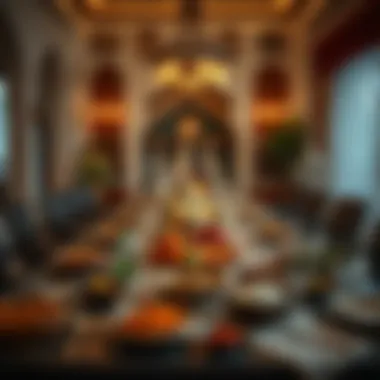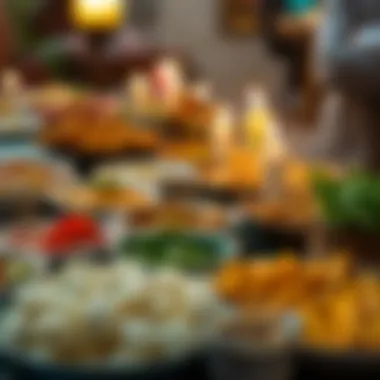Understanding Iftar: Significance and Timing During Ramzan


Intro
Iftar, the moment that breaks the day-long fast during Ramzan, stands not just as a ritual but as a celebration steeped in rich cultural significance. Across different regions, the time for Iftar is a slice of community, where families gather to share a meal, bond over shared traditions, and foster a spirit of togetherness. This article seeks to unpack the intricate layers that characterize Iftar, diving into its spiritual relevance, diverse regional customs, and the health implications that accompany this beloved practice.
Understanding Iftar goes beyond just knowing when to break the fast; it is about grasping the essence of nurturing relationships and cultural heritage. This narrative will explore various aspects, from the significance of precise timings to the unique ways different communities adapt their Iftar experiences. By examining these elements closely, we aim to provide readers with nuanced insights—essentially a roadmap through the multifaceted world of Iftar.
In doing so, we invite you to reflect on your own customs, and perhaps discover new perspectives that enrich your understanding of this sacred month.
Understanding Ramzan
Ramzan, also known as Ramadan, is not merely a month of fasting; it is a profound period rooted in tradition, spirituality, and community connection. Understanding the essence of Ramzan paves the way to appreciate its many layers of meaning, particularly in terms of Iftar—the meal enjoyed after sunset to break the fast. This phase of the Islamic calendar invites both reflection and community, making it essential for individuals to comprehend its significance.
Historical Context of Ramzan
The history of Ramzan traces back to the time of the Prophet Muhammad, who is believed to have received his first divine revelation during this month. This historical account not only imbues the month with spiritual weight but also sets the stage for its annual observance by millions around the globe. Historically, Ramzan has seen adaptations across cultures and eras, from elaborate communal feasts to solitary reflection.
As communities evolved, so did the ways in which they observe this sacred month. For instance, in many regions, fasting is accompanied by nightly prayers called Tarawih, contributing to a sense of deep communal bond. The historical significance of Ramzan cannot be overstated; it serves as a link between the past and the present, holding communities together through shared practice and cultural celebration.
Spiritual Significance of Fasting
Fasting during Ramzan is not solely about abstaining from food and drink; it represents a holistic spiritual journey aimed at self-discipline and heightened spirituality. The act of fasting incites a sense of empathy for the less fortunate, encouraging charitable acts and nurturing a sense of social responsibility among individuals.
Furthermore, the intention behind fasting is crucial. Muslims believe that fasting brings them closer to Allah, fostering a mindset of gratitude and a reflective nature. The discipline developed during these 30 days often leads to long-term shifts in behavior, making way for greater mindfulness in daily living long after the month has ended.
Global Observance Patterns
Observance patterns of Ramzan significantly differ across regions, reflecting diverse cultural interpretations and local traditions. For example, in countries like Turkey, extensive preparations for Iftar often begin days in advance, creating a festive ambiance. Conversely, in other regions, the focus lies more heavily on spiritual reflection and less on grand feasts.
In essence, while the core tenets of fasting remain constant, the cultural overlay adjusts its unique flavors. As a result, Ramzan is experienced through a kaleidoscope of practices that vary by geographical location, community, and individual preference. This diversity enriches the observance, infusing it with a global character while maintaining its profound religious significance.
The Importance of Iftar
Iftar marks a pivotal moment each day during Ramzan, serving not only as the conclusion of fasting but alsow as a profound social and cultural event. This meal embodies the values of community, gratitude, and reflection. When the sun sets, it represents a much-anticipated time to break bread and share warmth, drawing families and friends together.
Cultural Meaning of Iftar
Throughout various cultures, Iftar takes on unique expressions that reflect tradition and local customs. For instance, in many Middle Eastern countries, Iftar often starts with the consumption of dates and water, adhering to the tradition traced back to the Prophet Muhammad. Then, a lavish spread featuring a variety of dishes follows. Meals typically include soups, salads, and main courses that are heartier than usual.
Outside the Middle East, countries like Indonesia and Malaysia feature their own variations, such as the serving of Rendang or Roti John—a testament to the flexibility and adaptability of Iftar across diverse culinary landscapes.
The practice not only allows individuals to nourish their bodies after a long day of fasting but also strengthens ties within communities. Iftar is frequently a time for public gatherings, where mosques and community centers organize iftar dinners, symbolizing unity and shared spirituality. The collective breaking of the fast fosters a sense of belonging among participants, reinforcing cultural identity and shared values.
Social Gatherings and Community Impact
The social aspect of Iftar goes beyond just family meals. It serves as an occasion where neighbors come together, and friendships flourish. During Ramzan, many communities organize large iftar events to ensure that no one breaks their fast alone. These gatherings often include individuals from all walks of life, promoting inclusivity and social cohesion.
Moreover, the act of sharing food creates opportunities to bridge gaps between different cultural or socioeconomic groups. This harmony is especially significant in areas mixed with diverse populations. Events like community iftars have become platforms for discussions on mutual understanding, respect, and the importance of supporting those less fortunate.
"Iftar serves as a reminder that food is not merely sustenance but a beacon for togetherness and empathy, fostering community spirit during this significant month."
Additionally, the impact of Iftar is tangible from an economic perspective. Local businesses, restaurants, and catering services often see a spike in sales during this month, as many seek to prepare their iftar meals outside the home. This dynamic circulation of commerce ultimately supports the livelihoods of many, from local vendors selling dates to eateries offering special Ramzan menus.
Overall, Iftar stands as a profound reminder of community, charity, and gratitude. The shared experience of breaking the fast transcends mere ritual, transforming it into a movement that encapsulates culture, tradition, and social unity.


Iftar Timings: A Regional Overview
Iftar timings hold a monumental place in the observance of Ramzan. They not only signify the end of a day of fasting but also come intertwined with cultural, spiritual, and communal significances. Understanding these timings across different regions provides insight into the diversity within this shared practice. When it comes to Iftar, the time varies, which is often dictated by geographical location and solar movements. Therefore, knowing the precise moment to break a fast is pivotal, both for respect to the religious practice and gathering for communal meals that accompany this time.
Understanding Time Calculations
The calculation of Iftar timing is not as simple as it seems. It relies on several factors, primarily the position of the sun. Each location has its own sunset time, which marks the moment when the fast is to be broken. For many communities, it is a customary practice to break the fast right at sunset, while some choose to wait a few minutes more in case they mistakenly miscalculated the exact moment.
In regions that experience longer days during the summer, Iftar time can be especially late, which poses challenges for those observing the fast. This gives rise to a unique situation where the local calculation methods become critical. Common practices in various cultures include:
- Local mosques announcing the time through loudspeakers, serving as a community signal.
- Traditionally set clocks, modified to reflect the time zones of the sun.
- Mobile applications developed for Muslim communities, accurately calculating local prayer and Iftar times based on geographical coordinates.
Regional Variations in Timing
Iftar timings showcase fascinating regional variations. For instance, in a bustling city like Cairo, the sunset time can be around 6:30 PM, while in the northern parts of Norway, during certain periods of the year, fasts can last much longer, sometimes reaching nearly 20 hours or more until 11 PM or later. Here are a few notable variations:
- Middle Eastern countries: In Saudi Arabia, Iftar is typically announced with the sound of a cannon, making it an exciting community event.
- Southeast Asia: In Malaysia, Iftar often aligns with local announcements from mosques, with people gathering at food stalls in the evening.
- Western nations: In the UK, fasts may extend even longer during summer months where Iftar can be observed as late as 10 PM, accommodating both local practices and the long daylight.
These differences are not just practical— they also deeply impact the community interactions surrounding Iftar, where the time often reflects both social and cultural dimensions of the region.
Technological Aids for Accurate Timing
With the progression of technology, securing accurate Iftar timings has gained ease and efficiency. Several innovations have emerged to support Muslims in their observance:
- Mobile Applications: Platforms such as Muslim Pro and IslamicFinder provide users with real-time Iftar notifications based on their location. These apps often include additional features like daily Quran verses and prayer times.
- Online Resources: Websites like IslamicRelief.org offer downloadable calendars that account for Iftar timings across different regions.
- Community Websites: Many local mosques have begun to use digital platforms to regularly update the fasting schedules, ensuring everyone remains informed.
The increasing use of technology aligns with the modern lifestyle, allowing for a seamless integration of tradition in contemporary life.
Health and Nutrition Considerations
Understanding the health and nutrition aspects of Iftar is essential for anyone participating in the observance of Ramzan. This time of breaking the fast brings unique opportunities and challenges. It’s a moment not just for spiritual reflection, but also for physical replenishment. How one breaks the fast can significantly influence health and well-being, especially after long hours of abstaining from food and drink.
Breaking the Fast: What to Eat
When the sun sets and it’s time to break the fast, the meal must be approached with care. Traditionally, many start with dates and water. Dates are rich in glucose, fiber, and essential nutrients which help restore energy levels quickly. It's an age-old practice backed by wisdom: "Begin with the sweet, end with the hearty."
However, moving beyond just dates, one should consider a balanced approach to the entire meal:
- Complex Carbohydrates: Whole grains like brown rice or whole wheat bread provide sustained energy. They digest slowly, helping to avoid spikes in blood sugar levels.
- Proteins: Incorporating lean meats like chicken or fish, along with legumes, can help with muscle recovery and provide a feeling of fullness.
- Vegetables: A variety of colorful vegetables not only adds vitamins and minerals but also increases fiber intake, aiding digestion post-fast.
So when planning the menu, think both quantity and quality rather than making it a feast to overindulge.
Hydration and Iftar
Coming off a day of fasting, hydration is critical. Many overlook this aspect and dive into the food instead. However, proper hydration can set the stage for a healthier Iftar experience.
- Water: Drinking a glass or two of water before starting the meal is wise. It kicks off the digestive system eloquently.
- Soups: Consider beginning with a light soup. A broth made with spices not only helps with hydration but also warms the stomach after hours of fasting.
- Avoid Caffeinated Drinks: While tea and coffee are a staple for many, they can lead to dehydration. It's better to keep those for later, allowing the body to rehydrate fully first.
The goal, quite simply, is to replenish what’s lost and ease the body back into its rhythm.
Avoiding Common Pitfalls
In the hustle and bustle of gathering for Iftar, it’s easy to fall into patterns that can be detrimental to health. Being aware of common pitfalls can help ensure a balanced and enjoyable experience.
- Overeating: After hours of craving, the temptation to binge can be hard to resist. Taking time during the meal, savoring each bite, is important. It aids digestion and helps recognize fullness cues.
- Heavy Foods: Greasy or fried items may seem appealing but can lead to sluggishness afterward. Opt for lighter cooking methods, such as grilling or steaming.
- Neglecting Nutrient Variety: A common mistake is sticking to the same few dishes each day. Different foods provide different nutrients; mixing it up can keep meals interesting and nutritious.


"Health is wealth, even during the month of fasting."
Keeping these aspects in mind will not only aid in maintaining energy levels throughout the day but also foster a deeper appreciation for the Iftar meal itself. It’s about nourishment, connection, and mindful eating during this sacred month.
Culinary Traditions Around Iftar
Culinary traditions surrounding Iftar represent a melting pot of flavors, cultures, and communal bonding. This meal is not merely about breaking the fast; it serves as a vital cultural touchstone that brings families and communities together, fostering connections that transcend mere sustenance. The dishes served during Iftar reflect not only personal tastes and family recipes but also the rich tapestry of cultural influences that characterize different regions around the globe. Understanding these culinary practices is essential, as they provide insights into the local customs, social dynamics, and historical narratives that shape the observance of Ramzan.
Dishes Commonly Served
When the call to break the fast rings out, a myriad of dishes takes center stage on tables around the world. Some traditional foods may be humble but carry great meaning. A classic example is dates, often the first item to break the fast, symbolizing health and sweetness. Beyond dates, the spread can vary significantly:
- Samosas and spring rolls are often found in many households, offering crispy textures and savory fillings that warm the soul.
- Chickpea salad, a refreshing dish mixed with herbs and spices, has become a staple in many regions, promoting hydration after a long day without food.
- Lentil soup is another favorite, providing nourishment while also being easy on the stomach after fasting.
- More elaborate meals might include biryani or pulau, rice dishes that showcase saffron, spices, and meats, deeply rooted in South Asian culture.
The aromas of these foods—not to mention the colors—bring life to the evening. Interestingly, many families follow traditional recipes handed down through generations, merging personal history with communal identity.
Variations Across Cultures
The beauty of Iftar lies in its diverse interpretations throughout different cultures. Each region offers its unique culinary twist, influenced by local ingredients, historical factors, and traditions:
- In the Middle East, dishes like stuffed vine leaves and mahlabia (a milk pudding) have become synonymous with Iftar, highlighting the rich heritage of the region.
- North Africa showcases a delightful array of stews and tagines, with spices like cumin and paprika creating vibrant flavors that enliven the meal.
- Southeast Asia often includes Nasi Lemak, a fragrant rice dish paired with sambal, anchovies, and peanuts—emphasizing the region’s distinctive taste palette.
"Food during Iftar is more than just a meal; it encapsulates the essence of togetherness, culture, and celebration."
This cultural variety enriches the experience of Iftar, showcasing how shared practices can differ widely yet still hold similar meanings at their core. It serves to remind us that while fasting may be an individual endeavor, the breaking of that fast is a collective one, beautifully manifested through food.
Modern Practices in Iftar
As societies evolve and adapt, so too do the customs and practices surrounding Iftar during Ramzan. Understanding these modern practices becomes crucial in observing how traditions mesh with contemporary lifestyles and global influences. The importance of this section lies in its exploration of how traditions are reshaped, the benefits they bring, and the considerations that arise amidst these changes.
Influence of Globalization
Globalization plays a significant role in shaping Iftar practices today. With increased connectivity across the world, people are exposed to various cultural influences, leading to a blend of traditions and cuisines. For instance, in many urban centers, it's not just traditional dates and water that break the fast anymore; you might find an array of international dishes being served. Sushi and tacos have made appearances on Iftar tables, showcasing how diverse culinary influences enrich the experience.
This intersection of cultures can also be seen in the packaging of foods. Businesses now promote ready-to-eat Iftar boxes, catering to those with busy schedules who still wish to maintain the essence of the evening meal. Food deliveries incorporating regional favorites, coupled with global dishes, create a unique Iftar experience that respects both tradition and modern convenience.
Being mindful of this global influence can provide insights into collective identities. It helps people connect with others from diverse backgrounds, fostering a spirit of inclusivity. Engaging in cross-cultural Iftar can promote understanding and compassion, offering a platform for dialogue that transcends geographical boundaries.
Emerging Trends in Iftar Gatherings
Iftar gatherings have also undergone a transformation in their format and purpose. Here are some notable trends:
- Community-Based Events: Cities host larger community Iftar gatherings in public places, where diverse groups come together. These events promote unity, regardless of background, and often involve local charities, fostering a sense of giving.
- Themed Iftars: Some gatherings adopt specific themes—be it a focus on local cuisine, health-conscious choices, or even charity for socio-economic causes. These themed Iftars lead to a more immersive experience, often accompanied by educational elements that explore the significance of diverse foods.
- Hybrid Gatherings: With the rise in digital communication, more families are hosting virtual Iftar gatherings. Loved ones who cannot physically attend can join via video calls. This innovation keeps family traditions alive, regardless of distance.
- Focus on Sustainability: Many modern Iftar gatherings emphasize sustainability practices. From eco-friendly plates to food donations for those in need, gatherers focus on reducing waste and promoting communal support during the holy month.
"Traditions may change, yet their essence remains alive in the hearts of people."
To further explore the impact of globalization and evolving traditions, consider visiting resources like Wikipedia and Britannica.
The Role of Local Businesses in Iftar
Local businesses often hold a pivotal role during the month of Ramzan, especially concerning Iftar. These businesses are not merely providers of food but serve as hubs that foster community connections and cultural continuity. The significance of local enterprises in this context extends far beyond mere economic transactions; they contribute to the social fabric and shared spirituality of the observance.
Catering Services and Restaurants


Catering services and restaurants are the backbone of Iftar gatherings. As the sun dips below the horizon, families and friends flock to local eateries to indulge in iftar specials. These establishments often tailor their menus to reflect the traditions of the month, showcasing dishes that excite the palate and nurture community ties.
For instance, many restaurants create special family platters, offering a mix of traditional favorites like dates and lentil soup, alongside regional delicacies specific to the area. The preparation of these meals often draws from generations of culinary art, ensuring authenticity in flavors.
"Iftar isn't just about breaking fast; it's a celebration of togetherness," says Aisha, owner of a downtown café known for its communal Iftar dinners.
Additionally, local businesses can foster inclusivity by offering discounted rates or free meals to those in need. This gesture not only nurtures goodwill but also builds a positive brand image within the community.
Community Engagement Initiatives
The impact of local businesses goes beyond commerce; they are vital in driving community engagement initiatives. Many businesses collaborate with nonprofit organizations to collect food donations for the less fortunate during Ramzan. Events like food drives, charity iftars, or volunteering opportunities resonate deeply with the cultural significance of sharing and compassion inherent in the month.
Moreover, local entrepreneurs can become champions of community solidarity through collaborations that encourage people to connect. For instance, they might host workshops focusing on healthy eating or sustainability during the month of fasting. Such initiatives provide value beyond mere food offerings, instilling a sense of awareness and responsibility among participants.
Ultimately, the landscape of Iftar is enriched by the presence of local businesses. They are not just part of the commerce but are woven into the very fabric of the community’s cultural and social life during Ramzan.
In summary, both catering services and community engagement initiatives highlight the multifaceted role local businesses play during Iftar, significantly impacting cultural practices and interpersonal relationships within the community.
Reflections on Iftar Practices
This section explores how Iftar transcends mere nourishment and becomes a profound practice of reflection for individuals and communities during Ramzan. The act of breaking fast is often a time for introspection, shaping personal identities and cultivating a sense of unity in diverse societies. Examining the reflections surrounding Iftar processes helps illuminate personal stories and broader community impacts, ultimately enhancing our appreciation for this deeply rooted tradition.
Personal Experiences and Stories
Individual narratives surrounding Iftar can offer rich insights. Many people remember their first Iftar experiences, shaping their perception of communal and familial bonds. For instance, a young Muslim might recall the smell of delicious samosas and the sound of laughter echoing in a warm room. Similarly, stories often involve moments of generosity. One could recount how their family once opened their home to a neighbor in need, inviting them to join the feast as they shared dates and water to break the fast. These memories not only bring warmth but also reinforce values within families.
"Every Iftar has a story. It’s the small moments, like sharing my mother’s special lentil soup, that remind me of where I come from."
— Aisha, 32
As people share their experiences, patterns emerge in how Iftar serves to strengthen ties, whether among family or friends. In many cultures, stories of who brought what dish, or how much laughter filled the room, become cherished highlights. Additionally, personal anecdotes often emphasize the role of Iftar in spiritual development, with many recounting feelings of gratitude and mindfulness every evening at sunset.
Impact on Community Solidarity
Iftar serves as a catalyst for communal unity, further enriching the social fabric. Breaking bread together fosters a sense of belonging, a critical element in diverse urban contexts where individuals may feel isolated. Local mosques often coordinate large Iftar gatherings, drawing in folks from various backgrounds and increasing understanding and tolerance among different faiths.
The act of sharing Iftar becomes a meaningful ritual not just for those observing Ramzan, but for the entire community. These events often include invited guests from different cultures, creating dialogue and camaraderie. The participation of non-Muslims in Iftar events has also seen an uptick, paving the way for interfaith relations and mutual respect.
- Key factors that strengthen community solidarity through Iftar include:
- Open invitations that break down social barriers
- Collaborative cooking and preparation efforts
- Foundation of shared memories and collective experiences
Future of Iftar Celebrations
The future of Iftar celebrations presents a captivating landscape, one that reflects not only the vitality of cultural traditions but also the influence of modern technology and societal shifts. As globalization burgeons and communities increasingly intertwine, how Iftar is celebrated is bound to change in significant ways. It's essential to understand these evolving practices to appreciate how Iftar can continue to resonate with diverse groups while maintaining its core significance.
Predictions for Evolving Traditions
With each passing year, the way communities come together to break fast has shifted. Here are some elements which may characterize future practices:
- Diversity in Offerings: As culinary influences mingle, Iftar menus are likely to feature a potpourri of dishes from various cultures. For instance, a table that traditionally showcased dates and lentil soup might now include sushi or tacos, reflecting a fusion of tastes as much as a fusion of traditions.
- Inclusivity in Gatherings: Iftar dinners will increasingly embrace people from various backgrounds, promoting a blend of cultural narratives. This can enhance community ties as individuals share their unique approaches to fasting and breaking fast. So, expect local mosques to host open Iftars, inviting anyone irrespective of religious affiliation.
- Adaptation to Lifestyle Changes: As lifestyles shift, so must Iftar practices. Families now often juggle work and home responsibilities. Fast-break gatherings may adapt to suit the busy lifestyle of young professionals. Ready-to-eat meals or delivery services aimed at Iftar could see a rise, allowing individuals to break their fast on the go.
Role of Digital Platforms
one cannot underestimate the impact of technology on the future of Iftar celebrations. Digital platforms will play a crucial role in shaping how communities engage and celebrate. Consider some of the ways they might manifest:
- Online Invitations and Collaborations: Engaging communities through social media platforms can bolster attendance and foster connections. Groups may use Facebook events or Instagram polls to decide on Iftar themes or menu choices. Engaging different members in the planning will ensure the celebration is a reflection of the broader community.
- Virtual Gatherings: With an increase in remote work, virtual Iftars could become commonplace. Families separated by distance might gather through video calls, breaking bread while sharing experiences, thus preserving the spirit of togetherness despite physical barriers.
- Health and Nutrition Apps: As health consciousness grows, many might rely on mobile apps that emphasize balanced Iftar meals and hydration reminders. This embrace of technology encourages individuals to remain mindful about their nutrition as they end their fast.
Each of these aspects not only highlights the dynamism of Iftar traditions but also its adaptability in the face of change. By keeping an eye on technological advancements and societal trends, those involved in organizing Iftar events can ensure that these celebrations remain relevant and meaningful in the years to come.
The future of Iftar is not just a reflection of tradition but a canvas for modern expression.
For further information on the evolving nature of Iftar celebrations, consider visiting resources such as Britannica or community forums on Reddit. These platforms often shed light on the myriad ways people around the world choose to celebrate this pivotal moment in Ramzan.











